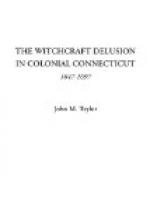CHAPTER V
“It was not to be expected of the colonists of New England that they should be the first to see through a delusion which befooled the whole civilized world, and the gravest and most knowing persons in it. The colonists in Connecticut and New Haven, as well as in Massachusetts, like all other Christian people at that time—at least with extremely rare individual exceptions—believed in the reality of a hideous crime called witchcraft.” PALFREY’S New England (Vol. IV, pp. 96-127).
“The truth is that it [witchcraft] pervaded the whole Christian Church. The law makers and the ministers of New England were under its influences as—and no more than—were the law makers and ministers of Old England.” Blue Laws—True and False (p. 23), TRUMBULL.
“One —— of Windsor Arraigned and Executed at Hartford for a Witch.” WINTHROP’S Journal (2: 374, Savage Ed., 1853).
Here beginneth the first chapter of the story of the delusion in Connecticut. It is an entry made by John Winthrop, Governor of the Massachusetts Bay Colony, in his famous journal, without specific date, but probably in the spring of 1647.
It is of little consequence save as much has been made of it by some writers as fixing the relative date of the earliest execution for witchcraft in New England, and locating it in one of the three original Connecticut towns.
What matters it at this day whether Mary Johnson as tradition runs, or Alse Youngs as truth has it, was put to death for witchcraft in Windsor, Connecticut, in 1647, or Martha Jones of Charlestown, Massachusetts, was hung for the same crime at Boston in 1648, as also set down in Winthrop’s Journal?
“It may possibly be thought a great neglect, or matter of partiality, that no account is given of witchcraft in Connecticut. The only reason is, that after the most careful researches, no indictment of any person for that crime, nor any process relative to that affair can be found.” (History of Connecticut, 1799, Preface, BENJAMIN TRUMBULL, D.D.)
“A few words should be said regarding the author’s mention of the subject of witchcraft in Connecticut.... It is, I believe, strictly true, as he says ’that no indictment of any person for that crime nor any process relative to that affair can be found.’
“It must be confessed, however, that a careful study of the official colonial records of Connecticut and New Haven leaves no doubt that Goodwife Bassett was convicted and hung at Stratford for witchcraft in 1651, and Goodwife Knapp at Fairfield in 1653. It is also recorded in Winthrop’s Journal that ’One —— of Windsor was arraigned and executed at Hartford for a witch’ in March, 1646-47, which if it actually occurred, forms the first instance of an execution for witchcraft in New England. The quotation here given is the only known authority for the statement, and opens




